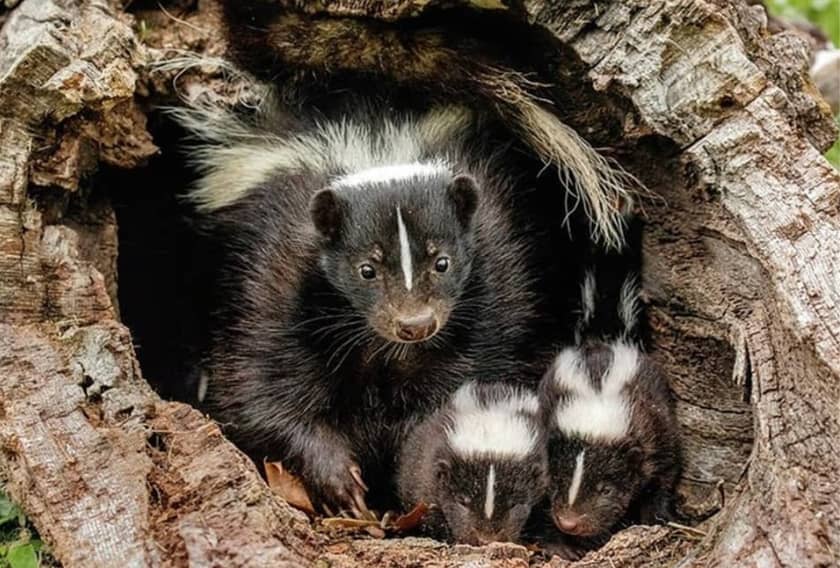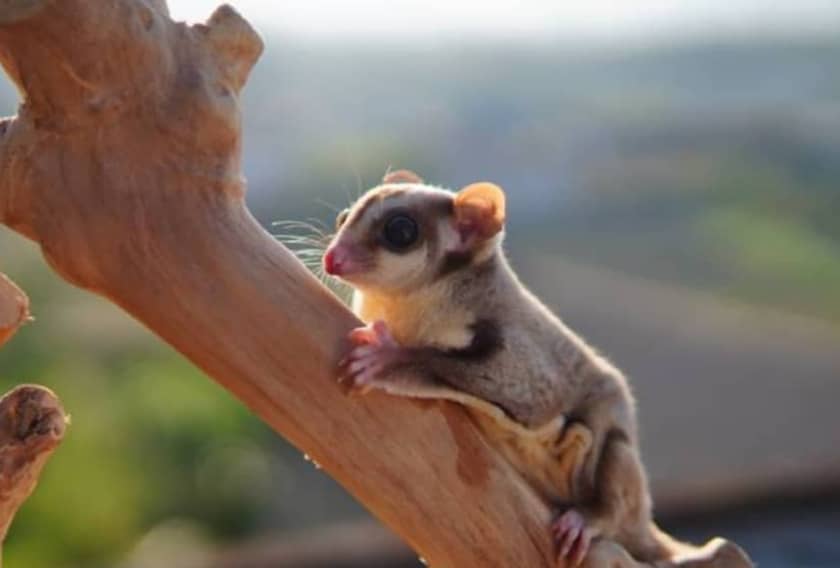Newborn flying squirrels are adorable little creatures, with their tiny paws and soft fur, and rely entirely on us to guide them through their delicate early days. These baby squirrels are known as kits.
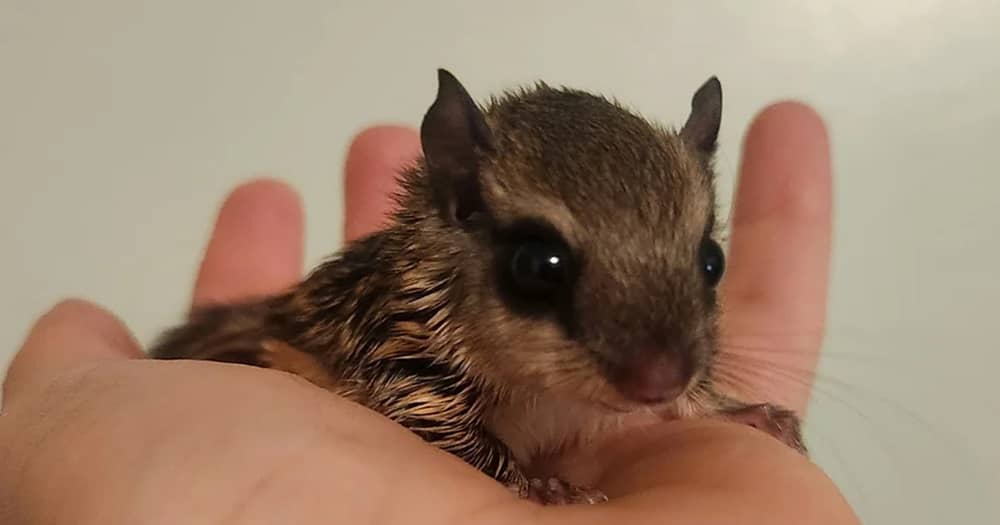
There are different species of flying squirrels, such as:
Northern Flying Squirrel:
A newborn Northern flying squirrel is a tiny, delicate creature found in North America. They are born blind, hairless, and dependent on their mother. Their skin is pink and translucent, revealing the delicate framework of their tiny bones and blood vessels.
As they grow, a thin layer of fur begins to develop. At birth, a Northern flying squirrel kit is typically measuring about 2-3 inches (5-7 cm) in length. They weigh just a few grams, making them extremely fragile.
Newborn Northern flying squirrels are born with their eyes closed. It takes about 24 to 30 days to open their eyes fully. One of the most distinctive features of flying squirrels, the patagium (gliding membrane), is not fully developed at birth.
Southern Flying Squirrel:
A newborn Southern flying squirrel, like its northern cousin, is an endearing little creature. It is distributed in deciduous and mixed forests over the eastern half of North America, from southeastern Canada to Florida.
Their skin is pink and almost translucent; it gradually becomes covered in soft, fine fur as they grow. A newborn squirrel weighs just a few grams, with the length around 2-3 inches. Their limbs are tiny and underdeveloped with soft, delicate claws. As the squirrel matures, these claws will strengthen, aiding in climbing and grasping. The patagia membrane begins to expand and become more functional as the squirrel grows.
Japanese Dwarf Flying Squirrel:
The Japanese dwarf flying squirrel, also known as ‘Pteromys momonga’, is one of the most attractive and captivating rodents. They are native to the Japanese islands of Honshu and Kyushu.
They measure 5-8 cm in length, including the tail, and weigh only a few grams. Japanese dwarf flying squirrels are born with closed eyes and transparent skin; their internal organs can easily be seen. Their ears are tiny and folded against the head at birth. They begin to unfold and become more prominent as the squirrel grows. Newborns are extremely dependent on their mother or caregiver for warmth, feeding, and protection.
Red Giant Flying Squirrel:
The Red Giant Flying Squirrel, one of the largest species of flying squirrels, native to Southeast Asia, starts life as an incredibly tiny and delicate newborn. At birth, the Red Giant Flying Squirrel is quite small compared to its adult size, measuring approximately 3-4 inches (7-10 cm) in length, including the tail.
They weigh only a few grams, making them extremely fragile and tiny. They were born with closed eyes and soft, pink, and translucent skin. The tail is short and thin at birth. As the squirrel matures, the tail will grow longer and develop into a bushy tail. Newborn Red Giant Flying Squirrels have a sparse coat of fine, soft fur that begins to grow shortly after birth.
Nest or Enclosure of Newborn Flying Squirrels
You require a carefully designed enclosure for your newborn flying squirrels to ensure warmth and security as they receive from their mother’s pouch.
Optimum Size
The size of an enclosure for your newborn squirrels needs to be small; a secure place is ideal, as it helps them feel protected and warm. The enclosure doesn’t need to be large. As they grow, they can be moved to a larger enclosure. You should ensure that the enclosure is escape-proof but well-ventilated to allow fresh air. You should avoid using wire cages for your newborn.
Bedding Material
You can line the bottom of the enclosure with soft and absorbent materials like fleece or cotton. Avoid using materials that cause irritation, like loose threads or straws. You can also use multiple layers of bedding to provide insulation and warmth to newborn flying squirrels, but it should be cleaned regularly.
Ideal Place
Newborn flying squirrels are not able to regulate their body temperature. So, the temperature between 85 and 90°F is ideal to keep them warm. You can also place a heating pad set under half of the enclosure, so the squirrel can go on the other side if feels warmer. Plus, you can also use a mall lamp at a safe distance, but you should always check the temperature to avoid overheating. A free area away from windows, doors, or air conditioning vents is an ideal place for the enclosure to prevent them from getting cold.
Safety
You can cover the enclosure with a cloth or towel to create a dark or cozy environment. You can include a small nesting box within the enclosure where baby squirrels can retreat, which helps them feel sheltered.
Cleanliness
Keep the enclosure clean and change the bedding regularly, especially when it gets soiled.
Diet of Newborn Flying Squirrels
Newborn flying squirrels require a careful diet to ensure they receive proper nutrients for growth and development. In the wild, a newborn flying squirrel’s diet consists of its mother’s milk.
This milk provides all the necessary nutrients, antibodies, and hydration needed for their development. If the mother is not available, a specially formulated milk replacer like Esbilac Puppy Milk Replacer, Zoologic Milk Matrix 33/40, or Fox Valley 32/40 can switch to Fox Valley 20/50 by 4 weeks old, designed for these small mammals. The milk is rich in fats, proteins, and essential vitamins that are crucial for their growth.
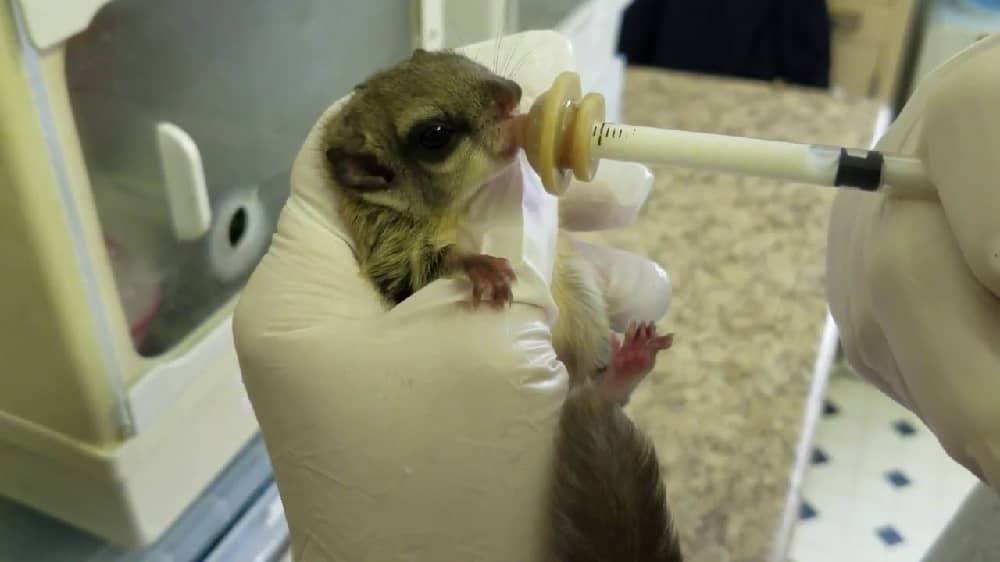 Newborns should be fed every 2-3 hours around the clock, even during the night. You can use a small syringe or a specialized feeding bottle. Start with small amounts, usually about 1-2 milliliters per feeding, and gradually increase the quantity as the squirrel grows.
Newborns should be fed every 2-3 hours around the clock, even during the night. You can use a small syringe or a specialized feeding bottle. Start with small amounts, usually about 1-2 milliliters per feeding, and gradually increase the quantity as the squirrel grows.
Give proper hydration to your newborn flying squirrels. Dehydration can quickly become life-threatening. If a newborn is showing signs of dehydration, an electrolyte solution such as Pedialyte can be given before resuming regular formula feeding.
You can also make and provide homemade milk formula, like
HOMEMADE GOAT MILK FORMULA PLUS
Ingredients:
- 3 tablespoons goat milk.
- 3 tablespoons plain yogurt.
- ½ egg yolk
- 2 tablespoons cream.
- Warm water
Most supermarket stores sell goat milk. If fresh goat milk is unavailable, canned or powdered milk can be used instead.
Note: Before using canned or powdered milk, mix it with water according to the packaging guidelines.
HGMF+ should not be used for longer than two weeks at a time since it is not completely enriched with vitamins and minerals. If you have no goat milk, double the yogurt (6 tablespoons).
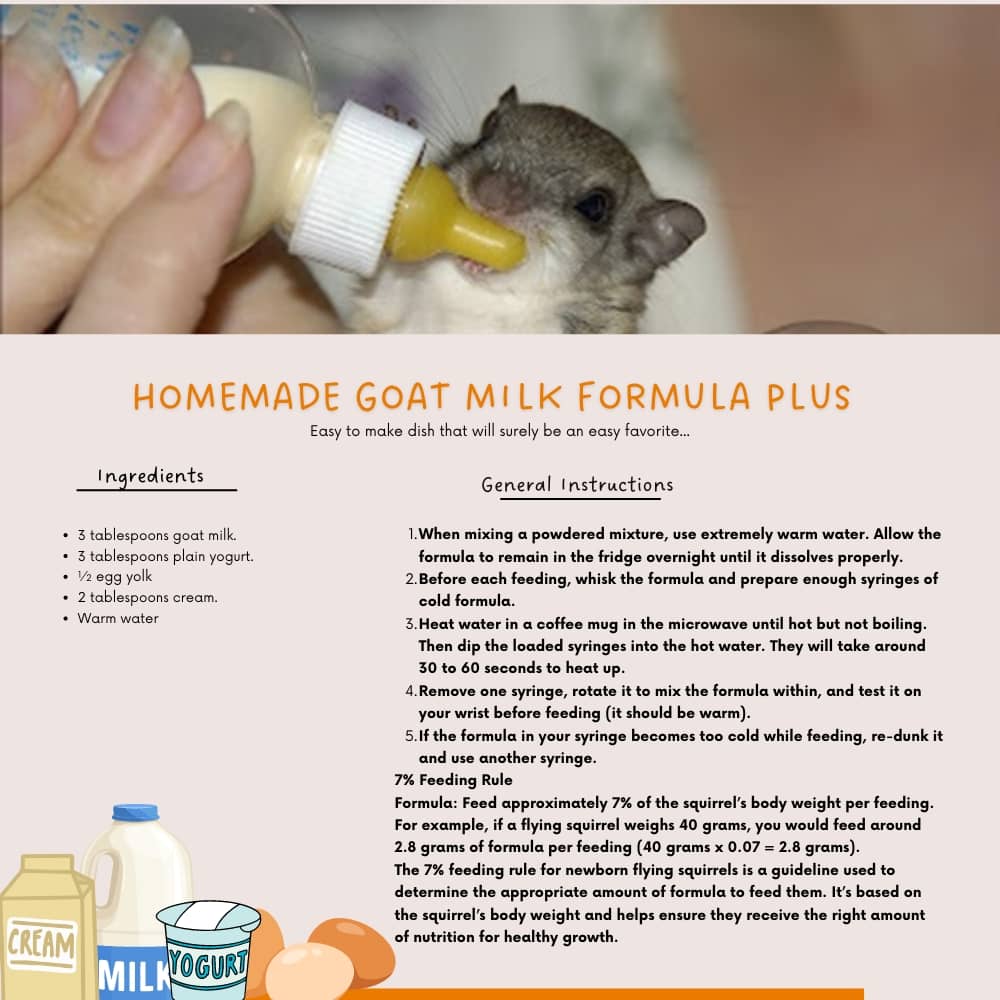
Instructions:
- When mixing a powdered mixture, use extremely warm water. Allow the formula to remain in the fridge overnight until it dissolves properly.
- Before each feeding, whisk the formula and prepare enough syringes of cold formula.
- Heat water in a coffee mug in the microwave until hot but not boiling. Then dip the loaded syringes into the hot water. They will take around 30 to 60 seconds to heat up.
- Remove one syringe, rotate it to mix the formula within, and test it on your wrist before feeding (it should be warm).
- If the formula in your syringe becomes too cold while feeding, re-dunk it and use another syringe.
7% Feeding Rule
Formula: Feed approximately 7% of the squirrel’s body weight per feeding.
For example, if a flying squirrel weighs 40 grams, you would feed around 2.8 grams of formula per feeding (40 grams x 0.07 = 2.8 grams).
The 7% feeding rule for newborn flying squirrels is a guideline used to determine the appropriate amount of formula to feed them. It’s based on the squirrel’s body weight and helps ensure they receive the right amount of nutrition for healthy growth.
Age of Weaning
Newborn flying squirrels are typically weaned off milk at around 6-8 weeks of age. During this period, they start to nibble on solid foods while still receiving milk. You can introduce small or soft foods like mashed fruits, vegetables, and specially formulated rodent blocks, which help their digestive system adjust to solid foods.
5 Basic Tips for Feeding the Newborn Squirrels
- Newborns should be fed slowly and patiently.
- Always handle the baby squirrels gently during feeding to avoid stress.
- Weigh the squirrel on a regular basis to check that they are acquiring the necessary amount of weight.
- If you allow baby squirrels to overeat, they can get diarrhea or bloating, both of which are deadly.
- Adjust feeding quantities as needed to account for their development and weight increase.
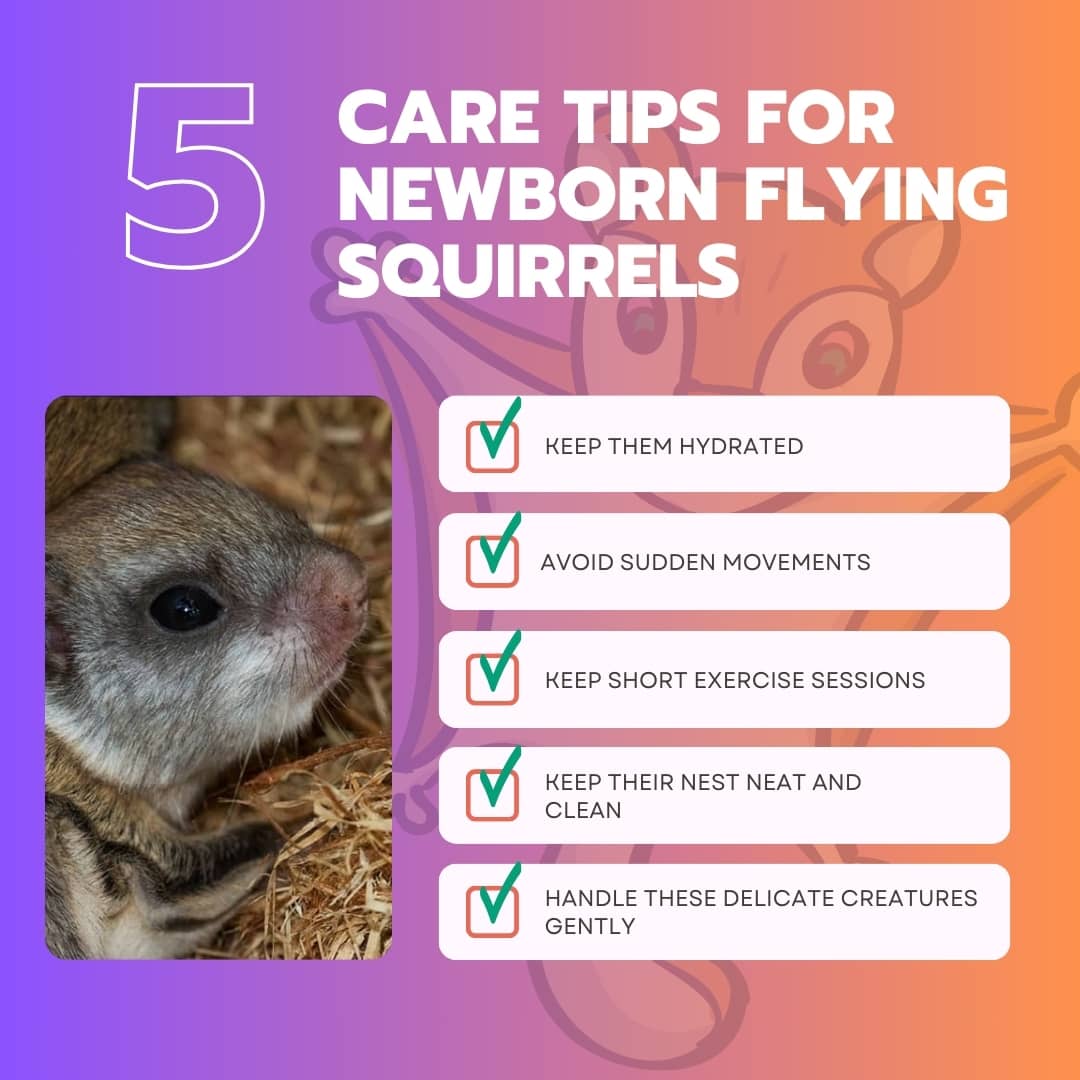
Health Issues
Newborn flying squirrels are very delicate and weak. Also, they are prone to various health issues. Some are:
Bloating:
This can occur due to too much intake of food. After eating, the stomach should be round yet soft. It should deflate before the feeding. If the stomach feels firm or does not deflate, miss a meal, hydrate, reduce the amount of formula at each feeding, or delay the feedings. Dip them in warm water up to his armpits and give them a gentle massage. A few drops of Gas-X are also helpful.
Malnutrition:
This can occur due to improper feeding practices, such as using the wrong formula or underfeeding. Symptoms can be poor growth, weakness, weight loss, a dull coat, and, in severe cases, skeletal deformities. You can use a high-quality milk replacer and adjust the diet under the guidance of a veterinarian.
Dehydration:
This can result from inadequate feeding, diarrhea, or high environmental temperatures. Symptoms are sunken eyes, dry or sticky gums, lethargy, or lack of urination. You must ensure they are receiving adequate fluids through regular feedings. You can offer an electrolyte solution like Pedialyte to rehydrate the squirrel or go to a veterinarian.
Aspiration pneumonia:
This occurs when a newborn inhales milk into their lungs during feeding. Symptoms are coughing, difficulty breathing, nasal discharge, lethargy, loss of appetite, and in severe cases, respiratory distress. This is a medical emergency and can be treated with antibiotics and supportive care.
Diarrhea:
This can result from improper feeding, a sudden change in diet, or stress. It can quickly lead to dehydration. Symptoms are loose or watery stools, frequent bowel movements, bloating, or discomfort. You can improve this by feeding the newborns with the appropriate formula and in the correct amounts. Do not make a sudden change in the diet. This can be treated by offering small amounts of electrolyte solution to maintain hydration or receiving appropriate treatment.
Bone and Joint Issues:
This is caused by nutritional imbalances, particularly in calcium and vitamin D. Poor diet and lack of sunlight exposure are common causes. Symptoms are weakness in the limbs, difficulty climbing, deformities, or limping. This can be managed by maintaining a balanced diet with adequate calcium and vitamin D. Severe cases may require veterinary intervention.
Constipation:
This can be caused by overfeeding, wrong formula, or parasites. If the diarrhea is watery, cease giving formula for a few feedings and hydrate instead. It may be beneficial to transition to the homemade goat milk formula. Diarrhea may kill swiftly, so seek medical attention immediately.
Smelly Urine:
When a newborn pees, it should not smell; otherwise, it signals a urinary tract infection. Antibiotics must be used to treat this; otherwise, neurological symptoms such as head shaking or tilting, loss of balance, and so on will occur.
Monitor the Health of Newborn Flying Squirrels
Monitoring the health of newborn flying squirrels is essential for ensuring their proper growth and development. They are extremely delicate and prone to several health issues.
Always watch for signs of healthy activity, such as regular feeding, steady weight gain, and active movement. Checking their hydration levels is also critical; immediate treatment may be required if they appear dehydrated or lethargic.
You should also pay close attention to their fur, eyes, and skin for signs of infections or abnormalities. A healthy newborn should have clear eyes, soft skin, and clean fur. Monitor their breathing as well—any signs of labored breathing or nasal discharge could indicate respiratory issues.
These tiny creatures need assessment of their body temperature since newborns cannot regulate it on their own and ensure they are kept in a warm, stable environment. If you notice any unusual symptoms or behaviors, it’s crucial to consult a veterinarian with experience with exotic pets promptly.
How to Handle Newborn Flying Squirrels?
Newborn flying squirrels require gentle care and patience. There are some Dos or Don’ts that you should follow with your newly borns to ensure their development.
Dos:
- Do handle them with a soft touch, supporting their entire body.
- Do ensure your hands are clean and warm before picking them up.
- Do limit handling time to essential tasks like feeding and cleaning.
- Do create a calm and quiet environment for handling.
- Do monitor their reactions to ensure they are not stressed.
Don’ts:
- Don’t grab them by their tail, legs, or head—always scoop them up gently.
- Don’t handle them for extended periods, especially in the early days.
- Don’t expose them to cold air or dry environments.
- Don’t handle them with dirty or scented hands.
- Don’t make sudden movements or loud noises while handling.
Grooming
In the wild, the mother uses her tongue to lick and clean them in furs or genital areas. In captivity, you can use a soft, damp cloth or cotton ball to gently wipe the newborn’s fur and the parts of the genitals.
Newborn flying squirrels should be gently groomed a few times a day, especially after feedings. Pay attention to areas that might be prone to chafing or where fur might be matted.
Their nails are very soft and tiny at first, so they usually don’t need trimming. But, as they grow, their nails can become sharp, which may cause scratches. You can use a small nail clipper designed for pets and only trim the very tip of the nails. As the newborn flying squirrels grow, they will start to groom themselves. You can encourage this natural behavior by providing a clean, comfortable environment where they feel secure.
Exercise
In the first few weeks of life, newborn flying squirrels don’t need formal exercise, as they are primarily focused on feeding, sleeping, and growing. You must ensure that they have space to stretch naturally within their enclosure.
Gentle movements of their limbs while you handle them can promote muscle activity without overstimulation. You can place a soft blanket or towel on a flat surface and lay the newborn on its belly for short periods to build the muscles.
Around 8-12 weeks, as they start to explore their environment and show more agility, you can introduce gentle glide training. You can use soft or padded surfaces to allow them to attempt short glides between low platforms.
As they grow, offer them small, soft toys or natural materials like leaves, branches, or bark. This stimulates their curiosity and encourages physical activity through play. You can also add small swinging toys or soft hanging materials inside their enclosure.
Newborn Care Tips
- Newborn and young flying squirrels are fragile and can easily injure themselves. Always supervise any exercise or play sessions to ensure their safety.
- When interacting with newborn flying squirrels, be gentle. Avoid sudden movements or handling that may cause stress or injury.
- Keep their nest or enclosure clean by regularly changing the bedding.
- Keep a close eye on their hydration levels.
- Flying squirrels are delicate creatures, and too much exercise can tire them out quickly. Keep exercise sessions short.
Frequently Asked Questions
Question 1: What should I feed a newborn flying squirrel?
Answer: Newborn flying squirrels should be fed a specialized milk formula such as Esbilac Puppy Milk Replacer or homemade Goat Milk Formula Plus.
Question 2:How often should I clean the newborn flying squirrel’s enclosure?
Answer: The enclosure should be cleaned regularly to maintain a healthy environment. Change the bedding every 2-3 days or sooner if it becomes soiled.
Question 3:Will my newborn flying squirrel’s poop change color with formula feeding?
Answer: It is normal for poops to change once they begin the formula. Normal formula poop is yellow/orange and consists of large, soft nuggets.
Question 4: What is the cost of caring for a newborn flying squirrel?
Answer: The cost of raising a newborn flying squirrel can vary depending on the species. On average, the cost of baby squirrels can be $500 to $3000. The baby squirrels are more expensive than adults.
Question 5: Can I bathe a newborn flying squirrel?
Answer: No, you should not bathe a newborn flying squirrel. They are too delicate, and exposure to water could lead to hypothermia. Instead, clean them gently using a warm, damp cloth to wipe away any dirt or waste.
Question 6: When can I start introducing solid food to a newborn flying squirrel?
Answer: Solid food can be introduced when the squirrel is around 4-6 weeks old. Start with small amounts of soft fruits, vegetables, and nuts in addition to their milk formula.
Question 7: Is it legal to own a newborn flying squirrel?
Answer: The legality of owning flying squirrels as pets varies by state or country. In some places, you may need a permit to keep them as pets, while in others, it may be prohibited.
Conclusion
Caring for newborn flying squirrels is both a rewarding and challenging experience that requires dedication, patience, and attention to detail. You should get a flying squirrel from a reputed breeder and understand its dietary requirements and other parameters. From providing a warm and secure environment to ensuring proper nutrition and hygiene, every aspect of their care plays a crucial role in their health and development.
Remember, each newborn flying squirrel is unique, and their needs may evolve as they grow. Always be prepared to adapt your care routine to their changing requirements and consult with a veterinarian experienced in exotic pets for any concerns.

